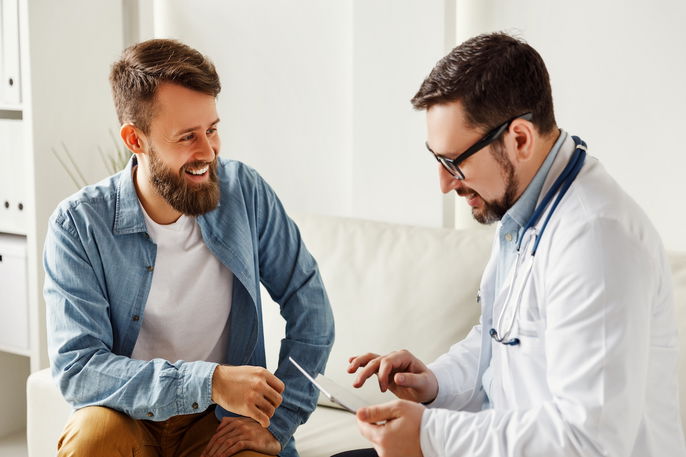Pubalgia is the inflammation of the pubic symphysis, which is the joint that joins the left and right hip bones in the front, between the thighs. Pain in this area can cause discomfort that is felt in the groin, lower abdomen and/or upper thighs.
Pubalgia is more common in people who are regularly active, and is especially felt in those who frequently run or play soccer. It can also be a symptoms of hip osteoarthritis or an inguinal hernia.
It is important to consult an orthopedist as soon as the first symptoms of pubalgia appear, so that a diagnosis can be confirmed and treatment can be started. Treatment for pubalgia may include rest, medication, physiotherapy or, in some cases, surgery.

Common symptoms
The main symptoms of pubalgia are:
- Groin pain, that is usually felt in the front of the body, where the left and right hip bones meet
- Lower abdominal pain
- Burning in the groin area
- Difficulty or pain when walking, running or climbing stairs
- Hip or leg weakness
- Reduced hip movement;
- Abdominal pain that radiates from the center of the pelvis
Pubalgia may worsen when standing on one leg or lying on your side, and after exercising or sex.
Pubalgia pain can also radiate from the groin to the upper thighs, testicles, perineum or genital area, or even cause pain in the lower back.
Also recommended: Groin Pain: 9 Common Causes & What to Do tuasaude.com/en/groin-painConfirming a diagnosis
A pubalgia is confirmed by an orthopedic surgeon, who will first assess your symptoms, health history and activity status. This is then usually followed by a physical examination.
In addition, the doctor may order imaging tests like an ultrasound, X-ray, CT scan, MRI or PET scan of the pelvic to confirm the underlying cause of groin pain and guide the most appropriate treatment.
Possible causes
The main causes of pubalgia are:
- Frequent exercise or sports, such as soccer, running or tennis
- Peripheral neuropathy
- Inguinal hernia
- Trauma to the pelvis, from a fall, for example
- Hip osteoporosis
- Hip osteoarthritis or osteoarthritis;
- A cyst in the pubic symphysis
Pubalgia may also occur due to pregnancy or after urological or gynecological procedures.
Pubalgia is often felt due to an imbalance or weakening of the muscles of the back and inner thigh and abdominal muscles. It leads to changes in the joint, as well as injury or swelling to the pubic symphysis area.
Treatment options
Treatment for pubalgia should be guided by an orthopedic surgeon, and is aimed at relieving pain, reducing groin swelling in the groin and promoting leg and hip movement.
The main treatment options for pubalgia include:
1. Rest
People who are active on a regular basis may be advised to rest and moderate their activity level to rest the pelvic joint. This can help to relieve pain and swelling.
The doctor may advise changing sports to low-impact physical activities during recovery, such as swimming.
2. Cold compresses
Applying a cold compress to the groin can help to reduce pain and relieve inflammation in the joint.
To make a cold compress, place ice inside of a thermal bag or place a gel pack in the freezer to cool.
Then wrap the bag or gel pack in a clean, dry towel and apply to the groin area for 15 to 20 minutes. This can be applied 2 to 3 times a day, for 7 to 10 days.
3. Physiotherapy
Physiotherapy may be indicated by the orthopedic surgeon and should be done under the guidance of a physiotherapist. It involves strengthening and stretching exercises to increase flexibility, improve pelvic stability, and relieve pelvic inflammation and pain. Exercises can also help to target abdominal and thigh muscles.
Physiotherapy should be individualized, with acute pain treated over t 6 to 8 weeks, and chronic pain being treated over 3 to 9 months.
4. Medication
The doctor may prescribe analgesic and anti-inflammatory medications, such as acetaminophen, ibuprofen or naproxen, as they help to reduce pain, relieve swelling and reduce joint inflammation.
These medications should always be prescribed by the doctor and treatment time should be determined on an individual basis, based on the patient's pain level and symptoms. .
5. Surgery
Surgery for pubalgia is only advised in the most severe cases, when physiotherapy is not enough to relieve symptoms or if the patient presents with worsening symptoms, like increased pain or swelling and difficulty walking or moving the leg.
In these cases, the orthopedist may recommend surgery to make the muscles in the region stronger, which can be done conventionally or through videolaparoscopy. After surgery for pubalgia, the doctor should provide a recovery plan so that the person can return to sports activities in about 6 to 12 weeks.






























